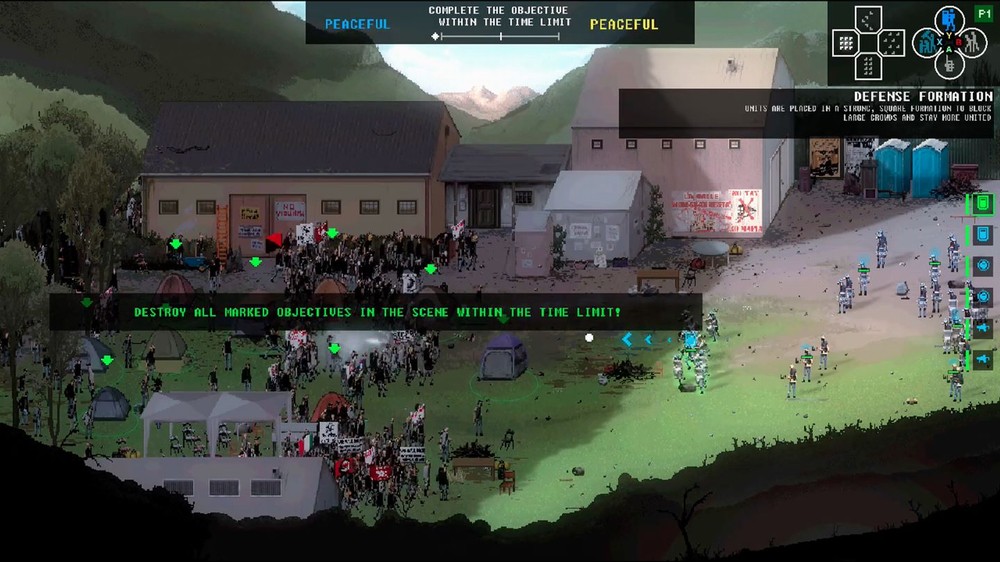Though a lot of games allow (and even encourage) the player to cause chaos, there are few that seek to actively portray a riot, and even fewer that attempt to do so seriously. Riot: Civil Unrest is a game that tries to put the player in the middle of a civilian uprising, and by controlling either the rioters themselves or the police, gives them the objective of fighting for a particular cause. Based on real-world events, Riot: Civil Unrest takes a number of riots from around the globe and gives players the chance to play through them, either bringing them to their actual conclusion or changing history in a virtual space.
There are three main components to Riot: Global, Story and Versus. Versus is the most self-explanatory, pitting you against the AI or another player in a variety of individual scenarios spread across the globe, while Global and Story are similar modes but with a twist to each. Story has you playing through the main series of protests that are featured in the game, through Italy, Greece, Egypt and Spain, and you take each event day by day. Global is a more gamified version of this, because as you play through you’re ranked on your performance, and how aggressive you are in your approach can determine how much public support you gain, which in turn affects how later events play out. You also unlock new abilities and characters in this mode by completing levels, which allows you to change your strategies and tactics for each level.
In terms of visuals, I was initially disappointed with Riot: Civil Unrest, but gradually became convinced that the aesthetic decisions made by the developers made sense in the context of the game. Riot is heavily pixelated, and at first this comes across as ugly, and makes text more difficult to read than it needs to be. However, once you get into playing the game, two things become apparent. Firstly, the game actually looks quite good in motion, with lighting effects that bring a vibrancy to proceedings. The pixilation actually brings a sense of authenticity to the game, as what you’re seeing on screen doesn’t look too far away from the graininess of most protest footage that is usually seen on the news, especially if it’s been captured on a cell phone. The second reason why the visual choices make sense is the fact that between the police and the protestors, there are often a large number of figures on screen, and a more intensive visual style would likely cause performance issues.
Riot doesn’t do the greatest job of explaining what you’re actually supposed to do during the game, or even how you’re supposed to do it. Thankfully, the controls aren’t too complicated, though they do take a little while to get your head around. Essentially, you select a group, and use the directional controls to direct them where to go. Once there, you can dictate whether they’ll act passively or aggressively, and this choice will often depend on the scenario that you’re playing. Some objectives require you to hold a certain location for a set period of time, some ask you to reach a certain spot on the map, and others ask you to either attack or defend particular items. Both sides have a series of abilities too: for example, protestors can gain a temporary resistance to smoke grenades, or gain the ability to throw firecrackers, which can startle your opponents.
I don’t think that enjoyment is the best descriptor to use for my time with Riot: Civil Unrest, but there were definitely moments of curiosity and intrigue. I found the moment-to-moment gameplay a little underwhelming, but for anyone with an interest in current affairs, history, or political science, this game is an excellent prompter to research areas you might not have previously been aware of. Though the majority of the riots depicted within the game happened within living memory, I wasn’t aware of most of them. I knew that I had seen some on the news, others I’m sure I’d clicked on the story and then forgotten about, and still others I may not have been exposed to at all. Riot: Civil Unrest offers brief outlines of why the riots are occurring and what people are fighting for or against, and lets the player decide if they want to delve deeper away from their console.
There are a lot of games that do things differently from their peers, and they will often be something similar to what we’ve seen before but with a bit of a twist, or they will at least be relatable to a genre that you may already be familiar with. Riot: Civil Unrest seems to defy genre labels, and presents an experience that is quite unlike anything I’ve played before, both in terms of gameplay mechanics and subject matter. It’s an experiment that doesn’t quite come off successfully, but it definitely made me think about what I was playing, which isn’t something that happens too often. I’m not even sure who I would recommend this game to either, as it’s in a category all of its own. What I’d suggest is take a look for yourself and see how you feel: it’s a game about thinking for yourself, after all. I’m sure that if the end result of playing the game is a bit more independent thought in the world, then Riot: Civil Unrest’s creators would be happy.












